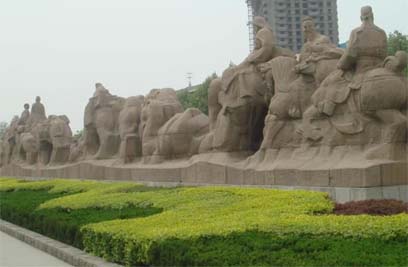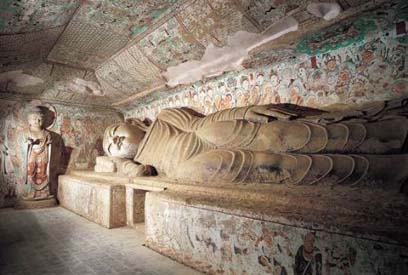China ancient Silk Road was a channel that ancient China had trade with Southern Asia, Western Asia, Europe and Northern Africa passing through Central Asia. Since large numbers of Chinese silk and silk products were transferred to the west through this channel, hence the name Silk Road.
According to the archaeological finds, the Silk Road was formed in Chinese Han Dynasty (202B.C. - 220). The south channel of the Silk Road at that time could reach the present Afghanistan, Uzbekistan and Iran in the west from Chang’an (present Xian). The other road could reach the end of the Persian Gulf, by passing Pakistan and Kabul of Afghanistan. If go south from Kabul, the road could lead to the present Karachi of Pakistan; if by ship, the road could lead to Persia and Rome.
During the period between the 2nd Century BC and the 2nd Century, along the Silk Road, from west to east, there were four empires on the route, Rome in Europe, Parthia in Western Asia, Kushan of Central Asia and Chinese Han Dynasty of Eastern Asia.
Through the complicated network of road system of the Silk Road, the East and West communicated and had trade frequently. According to ancient Chinese bibliography record, there were a mount of plants with “Hu (a Chinese character)” in the name such as the Hutao (walnut), Hugua (cucumber) and Huluobu (carrot), which were all from the West. It was during the Tang Dynasty from the 7th Century to the 9th Century, the Silk Road became the most prosperous. And the communication and trade between China and Western countries became more and more splendid. At that time, the rare birds and animals, perfume, jewelry, glassware, gold and silver coins, music, dance, food and clothes of Western and Central Asia were introduced to China. Meanwhile, Chinese products and technology such as the silk, papermaking technology, printing, lacquer ware, porcelain, gunpowder and compass were introduced to the West. The communication through the Silk Road made great contribution to the civilization of the whole world.
At the same time as the materials trade, the cultural communication through the Silk Road became more and more active. As one of the three large religions in the world, the Buddhism had been introduced to China in Western Han Dynasty (206 B.C.-220). The Xinjiang Kizil Grottoes excavated in the 3rd Century, contains the murals of nearly  10,000 square meters, which reflects the trace that the early Buddhism was introduced to China from India. The Buddhism was supposed to be introduced to inner China from India, passing through the Silk Road, reached Kizil Grottoes of Xinjiang, Dunhuang of Gansu and finally arrived in inner China. Along the Buddhism caves left on the Silk Road, such as the Mogao Caves, Longmen Grottoes in Luoyang and more, you will find that most of the sites have both eastern and western’s art style. They have become the proof of the cultural communication of the East and West, and also become the World Heritage Sites. 10,000 square meters, which reflects the trace that the early Buddhism was introduced to China from India. The Buddhism was supposed to be introduced to inner China from India, passing through the Silk Road, reached Kizil Grottoes of Xinjiang, Dunhuang of Gansu and finally arrived in inner China. Along the Buddhism caves left on the Silk Road, such as the Mogao Caves, Longmen Grottoes in Luoyang and more, you will find that most of the sites have both eastern and western’s art style. They have become the proof of the cultural communication of the East and West, and also become the World Heritage Sites.
After 9th Century, with the political and economical change of Europe and Asia, especially with the improvement of seamanship, the shipping started to play an important role in trade. However in 10th Century (Chinese Song Dynasty), the Silk Road had been seldom used in trade.
The Silk Road, with a long history, played a very important role in the process of world’s civilization. In recent years, the UNESCO proposed a New Research Plan of the Silk Road, which was called the Dialogue Road, to promote the dialogue and communication between East and West. |
